Can an Eye Test Detect Diabetes?
Published: 19 Apr 2025
You might be thinking, “Can an eye test detect diabetes? It’s a common thought. But surprisingly, your eyes can give away the early signs of diabetes even before symptoms appear elsewhere in your body.
This article will clear your doubts, explain how eye tests uncover hidden signs of diabetes, and guide you on what to do next.
1- How Diabetes Secretly Damages Your Eyes
When you have diabetes, your blood sugar levels stay higher than normal for too long. This extra sugar can damage many parts of your body, including your eyes.
What Really Happens Inside Diabetic Eyes?
Imagine the blood vessels in your eyes as tiny pipes. When sugar levels are too high, it’s like too much pressure building inside the pipes, causing them to weaken and leak. This leaking is called diabetic retinopathy.
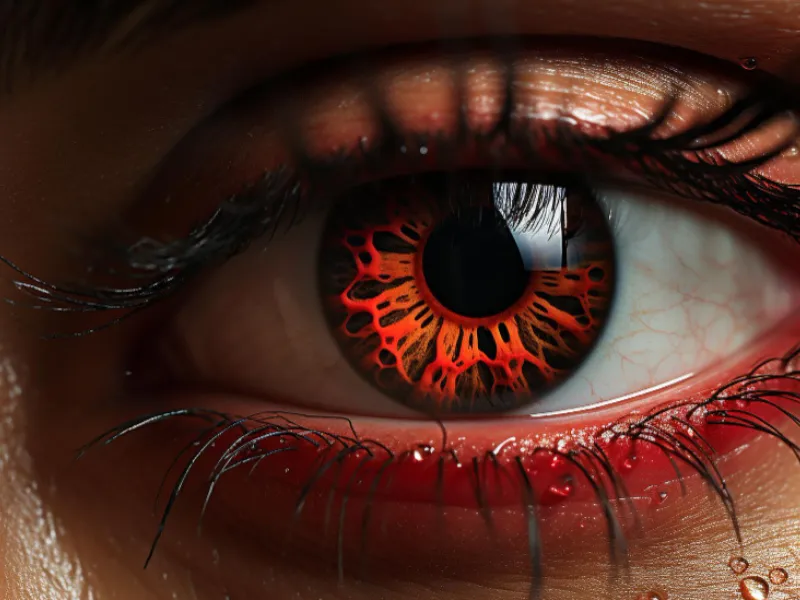
From a medical standpoint, this makes complete sense because diabetes harms the tiny blood vessels inside your eyes, especially in an area called the retina (the part that helps you see clearly). (1)
Over time, these leaks can cause:
- Swelling in the retina
- New, weak blood vessels to grow (which can bleed)
- Vision loss if not treated early
Most medical experts agree that diabetic retinopathy often starts without any symptoms. That’s why regular eye exams are super important, even if your vision seems fine. (2)
Wondering how doctors can spot these hidden signs? Let’s see it deeply.
2- Can an Eye Test Detect Diabetes? Even Before You Feel It
Based on my experience, an eye test can’t directly diagnose diabetes, but it can reveal signs of diabetic retinopathy, which is a common complication of diabetes.
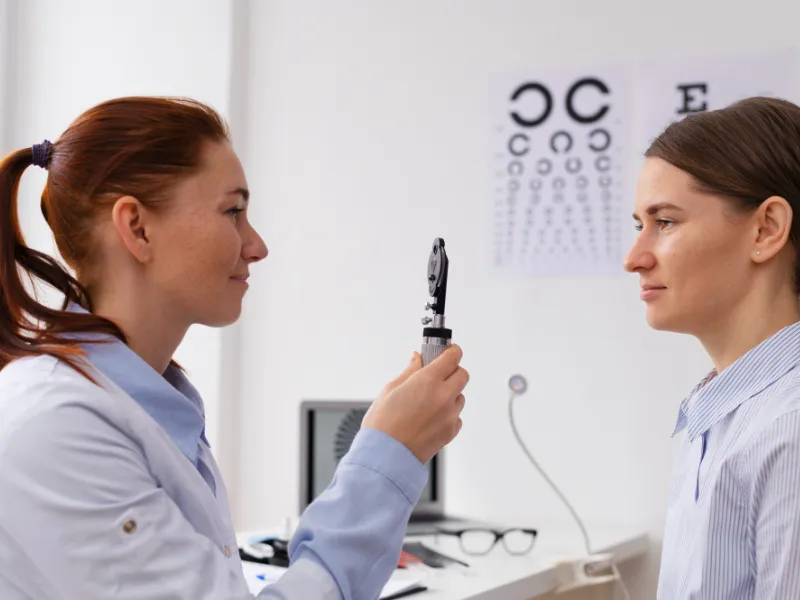
This condition affects the blood vessels in the retina and often occurs when diabetes isn’t well-controlled.
But wait, diabetic retinopathy isn’t the only thing to watch for. There’s more you need to know!
| 2.1 Other Eye Problems Diabetes Can Cause |
|---|
Most medical experts agree that diabetes doesn’t just cause retinopathy. (3) It can lead to other serious eye issues, too:

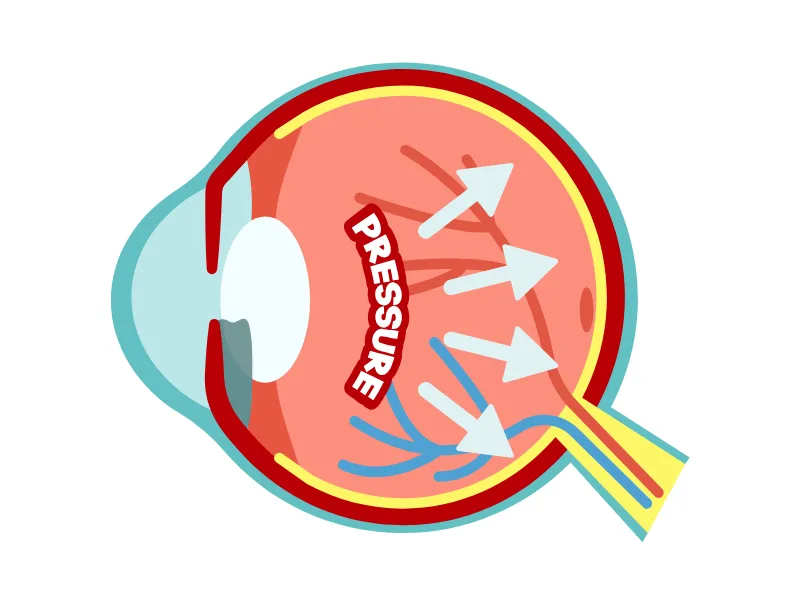
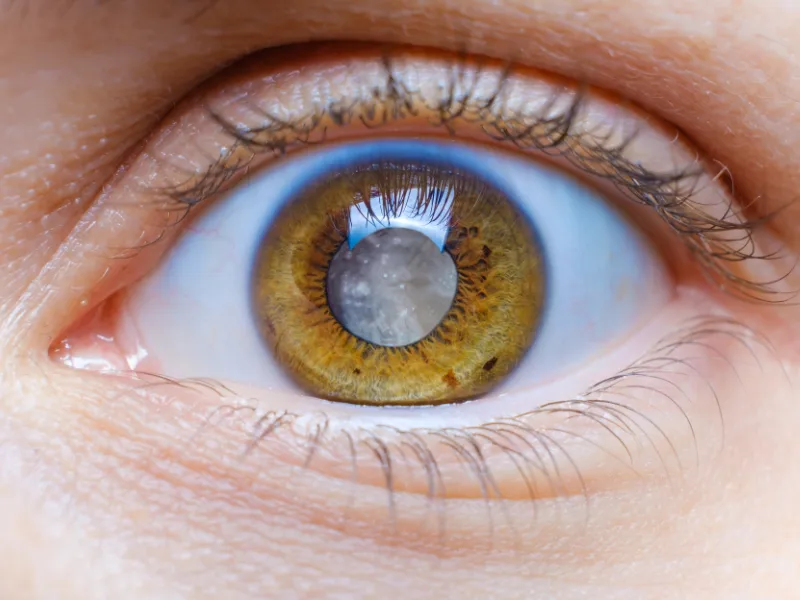 |
2.2 How Eye Doctors Spot Diabetes During an Exam
The doctor usually does three main steps:
- Dilated Eye Exam:
The doctor puts special drops in your eyes to widen (dilate) your pupils. This lets him see the back of your eye more clearly.
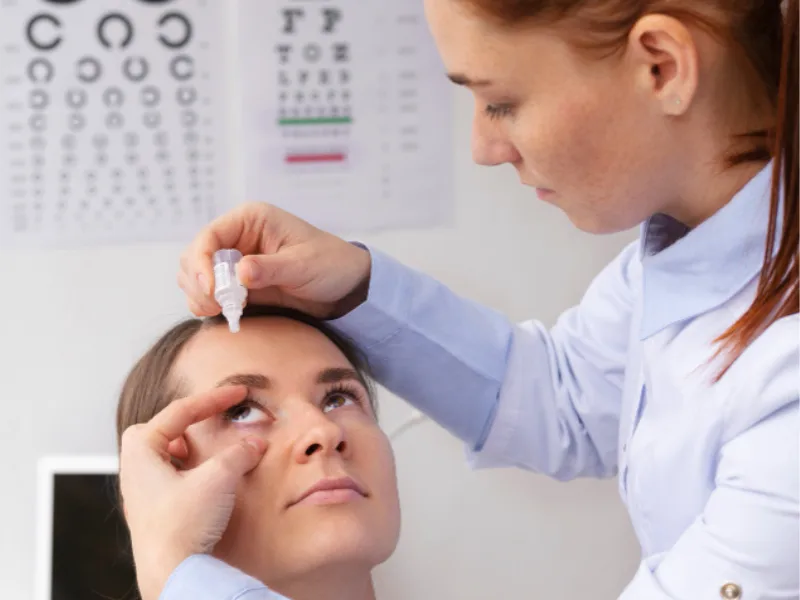
- Retinal Check:
Using a bright light and magnifying lens, the doctor checks your retina for swelling, bleeding, or leaky blood vessels, which are the common signs of diabetic damage.

- Imaging Tests:
Sometimes, they take detailed pictures (fundus photography) or do a 3d scan (OCT scan) to look for early changes that you can’t feel yet.
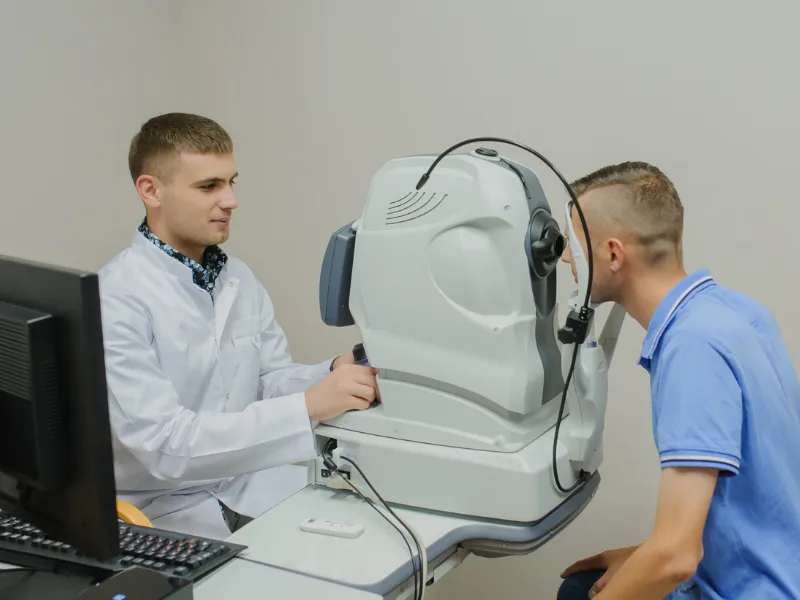
If the doctor sees any signs of diabetes, he will recommend a blood sugar test to confirm it.
If you have diabetes, your eye doctor might spot small blood vessel leaks or swelling in your retina during a routine eye exam.
These signs can alert them to diabetes-related damage, sometimes before you even notice any changes in your vision.
- Leaking blood vessels: Blood vessels in the retina that leak fluid or blood due to damage caused by high blood sugar.
- Swelling: This happens when fluid builds up in the retina, making vision blurry.
- Abnormal blood vessel growth: Sometimes, new blood vessels form in the retina as a result of damage; these vessels are fragile and can cause more harm.
Curious how early your eyes can show signs of diabetes? Let’s find out next.
3- How Early Can Your Eyes Warn You About Diabetes?
An eye test can sometimes detect your signs of diabetic retinopathy even before you are officially diagnosed with diabetes.
In fact, during your thorough eye exam, the doctor may notice changes in the eye that suggest elevated blood sugar levels, potentially hinting that you are at risk for developing diabetes.
So, if an eye test is not enough by itself, what can you do? Stick with me, we’re covering that too.
3.1 Why Eye Tests Alone Can’t Confirm Diabetes
While an eye test can highlight potential complications from high blood sugar, most medical experts agree that it cannot officially diagnose diabetes.

The test only reveals damage or changes that may have been caused by the disease. In other words, the eye exam can suggest the possibility of diabetes, but a proper blood test is needed for a confirmed diagnosis.
Medical professionals usually suggest an official diagnosis of diabetes, which requires specific blood tests, like:
- Fasting Blood Sugar Test: Measures your blood sugar after fasting for at least 8 hours.
- HbA1c Test: Shows your average blood sugar levels over the past 2-3 months.
3.2 Easy Tips to Catch Diabetes Early Through Eye Exams
I always tell my patients that regular eye exams can be an important step in early detection. They can catch eye complications like diabetic retinopathy early, allowing for quicker intervention.

Even if you don’t have symptoms of diabetes, getting your eyes checked regularly can serve as a preventative measure for spotting complications related to diabetes before they get worse. Trust me, I have seen this work countless times.
4- Real Stories and Experiences
Many patients have shared their personal experiences on Reddit.
4.1 Blurred Vision and Uncontrolled Diabetes:
- One user shared that during uncontrolled blood sugars (330-600+ mg/dL), they had blurred vision and needed strong reading glasses (2-2.5 readers) just to walk around.
- Another mentioned rubbing their eyes often during uncontrolled diabetes to try to clear their blurry vision.
- A third person said blurry vision was their first warning sign that blood sugar was dangerously high.
4.2 Eye Exams for Diabetes:
- Several users mentioned getting a yearly diabetic eye exam, often covered by government programs like the NHS.
- The diabetic eye exam usually includes pupil dilation and a retinal check for signs of diabetic damage.
- One user explained that the diabetic eye exam also checks for cataracts and glaucoma alongside retina health.
- Some users said results are shared with their primary doctor and endocrinologist to monitor diabetes progress.
- One person added that if the eye exam is done for medical reasons (like diabetes), the cost might be lower compared to a regular vision test.
4.3 Real-Life Experiences:
- A user who had diabetes for 30 years said the diabetic eye exam feels similar to their regular nearsighted eye checks, but now includes a formal retina scan.
- Another user mentioned getting annual retinopathy screening and basic vision check-ups after being diagnosed with diabetes 4 years ago.
- Someone shared they had their first diabetic eye exam recently, which involved dilating drops and flashlight checks. Their doctor said their eyes looked healthy.
See how real people caught early signs? Their experiences show why regular eye checks are so powerful. Let’s explore more!
Based on my experience, I have seen many cases where early detection has saved sight and health.
- Blurry Vision: Blurry vision that comes and goes might signal fluctuating blood sugar levels affecting your eyes.
- Dark Spots or Floaters: Unexpected dark spots or floaters could be a sign of diabetic eye issues like retinopathy.
- Trouble Seeing at Night: Difficulty seeing in low light may indicate retinal damage from diabetes.
Ignoring small vision changes can be easy, but if you catch them early, you can take action to manage not just your eyes but your overall health. It’s always better to get things checked out sooner rather than later. (7)
6- When Should You Get an Eye Exam for Diabetes?
6.1 If You’re Already Diabetic
- For Type 1 Diabetes:
- First Eye Exam: Within 5 years of your diagnosis. Since diabetic retinopathy can develop over time, it’s important to catch any issues early.
- Follow-Up: Once a year for regular check-ups, or more often if your doctor recommends it based on the condition of your eyes.
- For Type 2 Diabetes:
- First Eye Exam: At the time of diagnosis. Many people with type 2 diabetes may already have some signs of diabetic retinopathy, even if they don’t have symptoms.
- Follow-Up: Again, once a year, or more frequently if necessary, based on your doctor’s advice.
- First Eye Exam: At the time of diagnosis. Many people with type 2 diabetes may already have some signs of diabetic retinopathy, even if they don’t have symptoms.
6.2 If You Don’t Have Diabetes
- Routine Eye Exams:
- Even if you don’t have diabetes, it’s a good idea to get regular eye exams to catch early warning signs of potential complications, including diabetic retinopathy, especially if you’re at risk.
- Even if you don’t have diabetes, it’s a good idea to get regular eye exams to catch early warning signs of potential complications, including diabetic retinopathy, especially if you’re at risk.
- People at Higher Risk Should Get Routine Exams:
- Family History of Diabetes: If someone in your family has diabetes, you may be at a higher risk.
- Overweight or Obese: Being overweight increases your chances of developing diabetes, which can affect your eyes.
- Blurry Vision or Other Changes: If you experience changes like blurry vision, dark spots, or difficulty seeing at night, don’t ignore them; these could be early signs that something’s off.
- Family History of Diabetes: If someone in your family has diabetes, you may be at a higher risk.
Ready to protect your eyes and health? Here are five simple steps you can start today!
| 7- Mini-Tip List: 5 Simple Ways to Protect Your Vision With Diabetes |
|---|
|
If you’re curious to learn more about how diabetes affects your health, don’t miss these helpful reads:
8- Final Thought: Can an Eye Test Detect Diabetes?
So, guys, in this article, we’ve covered the question Can an Eye Test Detect Diabetes? in detail. While an eye exam can’t directly diagnose diabetes, it plays a crucial role in spotting early signs of complications that come with the disease.
As someone who’s seen the impact of delayed diagnosis firsthand, I suggest being proactive and getting your eyes checked regularly. Take charge of your health, book your eye exam today!
Found this helpful? Share it with your friends
9- FAQs: Can an Eye Test Detect Diabetes?
No, an eye test can’t diagnose diabetes. It can, however, detect signs of complications related to diabetes, like diabetic retinopathy, which may indicate high blood sugar levels.
Diabetic retinopathy is a condition where high blood sugar damages the blood vessels in the retina, causing blurry vision or even vision loss if untreated.
If you have diabetes, it’s recommended to get an eye exam once a year to monitor for any changes in your eye health.
Yes, managing your blood sugar levels and maintaining a healthy lifestyle can reduce your risk of diabetic retinopathy and other complications.
Diabetes can also increase the risk of cataracts (clouding of the lens) and glaucoma (increased pressure in the eye), which can affect vision.
Yes, blurry vision can sometimes be an early sign of diabetes, especially if it comes and goes, due to fluctuations in blood sugar levels.
High blood sugar can damage the small blood vessels in the eyes, leading to issues like swelling, leaking vessels, and abnormal growth of new blood vessels.
Yes, eye exams can sometimes reveal early signs of diabetic retinopathy before diabetes is diagnosed, but you’ll need a blood test to confirm the disease.
If an eye exam shows signs of damage, your doctor will likely recommend blood tests to check your blood sugar levels and determine if you have diabetes.
Yes, controlling your blood sugar through diet, exercise, and medication, quitting smoking, and scheduling regular eye exams can help protect your vision from diabetes-related complications.
10- References
At MedicaWire, all medically sensitive content is reviewed by licensed healthcare professionals. Our team ensures that the information you read is accurate, up-to-date, and based on trusted medical sources.
Learn how we maintain high standards by reading our Editorial Policy.
📚 Sources
- Diabetes and eye disease
https://ufhealth.org/conditions-and-treatments/diabetes-and-eye-disease - Fairless E, Nwanyanwu K. Barriers to and Facilitators of Diabetic Retinopathy Screening Utilization in a High-Risk Population. J Racial Ethn Health Disparities. 2019 Dec;6(6):1244-1249. doi: 10.1007/s40615-019-00627-3. Epub 2019 Aug 28. PMID: 31463812; PMCID: PMC6880869.
- Sayin N, Kara N, Pekel G. Ocular complications of diabetes mellitus. World J Diabetes. 2015 Feb 15;6(1):92-108. doi: 10.4239/wjd.v6.i1.92. PMID: 25685281; PMCID: PMC4317321.
- What Diabetics Should Know About Blood Sugar Levels and Vision
https://vnahg.org/what-diabetics-should-know-about-blood-sugar-levels-and-vision/ - Diabetic Eye Disease
https://www.niddk.nih.gov/health-information/diabetes/overview/preventing-problems/diabetic-eye-disease - Vision Loss and Diabetes
https://www.cdc.gov/diabetes/diabetes-complications/diabetes-and-vision-loss. - Cooper BA. Ten Key Elements of a Diabetes-Related Eye Examination. In: A Practical Guide to Diabetes-Related Eye Care. Arlington (VA): American Diabetes Association; 2022 Jul. Available from: https://www.ncbi.nlm.nih.gov/books/NBK582424/ doi: 10.2337/db20223-4
- Diabetic Eye Disease
https://www.niddk.nih.gov/health-information/diabetes/overview/preventing-problems/diabetic-eye-disease
ℹ️ Our Promise
MedicaWire follows strict sourcing guidelines and only references peer-reviewed studies, academic institutions, and reputable medical associations. We update content regularly to reflect new health information.

- Be Respectful
- Stay Relevant
- Stay Positive
- True Feedback
- Encourage Discussion
- Avoid Spamming
- No Fake News
- Don't Copy-Paste
- No Personal Attacks



- Be Respectful
- Stay Relevant
- Stay Positive
- True Feedback
- Encourage Discussion
- Avoid Spamming
- No Fake News
- Don't Copy-Paste
- No Personal Attacks




